Ladybugs, also known as ladybirds or lady beetles, are small bugs belonging to the Coccinellidae family. They are often celebrated in children’s literature and folklore and are generally seen as beneficial insects.
While they are commonly recognized for their bright red color with black spots, there are several species that are brown or tan in color. These brown ladybugs are just as beneficial as their red counterparts, often feeding on pests like aphids and mites.
This article delves into the various types of brown ladybugs and provides insights on how to identify them and if they are dangerous or not.
What are Brown Ladybugs?
Brown ladybugs are a unique variety of seasonal ladybugs that are not as prevalent as their red and black counterparts. Scientifically known as Coccinellidae, brown ladybugs are a diverse family of beetles that boast more than 6,000 species worldwide. While most ladybugs are beneficial, feeding on plant-eating insects, some species, especially the brown ones, can become a nuisance.
Recognizable for their distinctive domed bodies and contrasting spots, these insects play a pivotal role in maintaining the ecological balance of various ecosystems. Their importance in pest control cannot be overstated, as they are among the most effective predators of aphids and other plant-damaging insects.
Here’s a concise overview of brown ladybugs:
| Size | Appearance | Variability | Examples |
|---|---|---|---|
| They measure between 0.12” and 0.20” (3 – 5 mm), making them relatively small. | They are characterized by their brown hue, often accompanied by white spots. This makes them hard to spot on plants | Forest Lady Beetle (Territoria brunnea) showcases a deep brown hue with faint yellow markings. They exhibit a range of patterns, including being brown with yellow stripes, entirely brown without any distinct markings, or even bearing a resemblance to the classic yellow and black ladybugs. | Convergent Ladybug (Hippodamia convergens) Asian Lady Beetle (Harmonia axyridis) Two-Spotted Lady Beetle (Adalia bipunctata) Thirteen-Spotted Lady Beetle (Hippodamia tredecimpunctata) Twice-Stabbed Lady Beetle (Chilocorus stigma) |
Ready to take the next step? Book your free consultation now! We proudly serve a wide range of areas including Huntsville, Decatur, Florence, Guntersville, Cullman, and many more.
Why Are Some Ladybugs Brown?
Some ladybugs are brown as a result of their evolutionary adaptations. Brown ladybugs, for instance, rely on their camouflage to protect themselves from predators. They are among the least toxic of the ladybug species.
On the other hand, orange-tinted ladybugs contain more toxins and can be more allergenic to humans. Red ladybugs, which are less poisonous than orange ones, have their own defense mechanisms.
Varieties of Brown Ladybugs
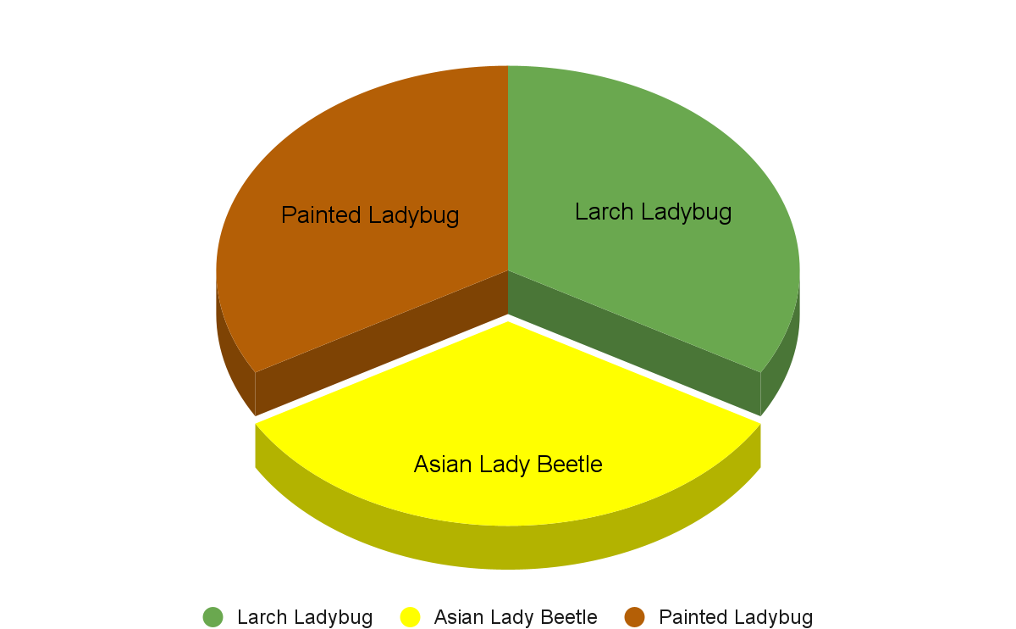
In the vast tapestry of ladybug species, brown ladybugs are often overshadowed by their more vibrantly colored counterparts. However, their subtlety in color does not diminish their significance.
Brown ladybugs show a spectrum of shades, patterns, and sizes, making them a great subject of study for entomologists and nature enthusiasts alike.
These insects can range from light tan to deep chestnut, with variations in spots, patterns, and body structure that pose unique challenges for identification.`
1. Common Brown Ladybugs
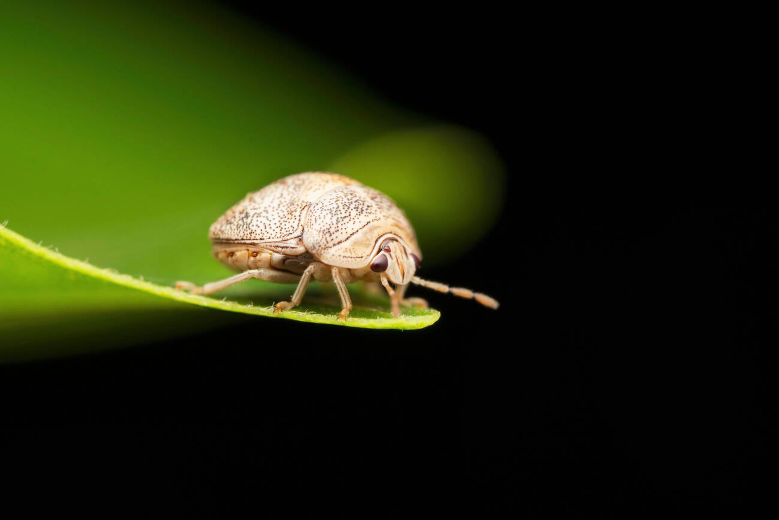
These ladybugs are characterized by their tan, dark brown, chestnut, or mahogany colors. Their ability to blend seamlessly with their surroundings, especially on plants, shrubs, and trees, makes them hard to spot. Their camouflage is an evolutionary adaptation that helps them avoid predators.
- Kudzu Bug (Megacopta cribraria)
- Brown Carpet Beetle (Attagenus smirnovi)
- June Bugs (Melolonthinae Phyllophaga)
- Mealybug Ladybug (Cryptolaemus montrouzieri)
2. Asian Lady Beetles
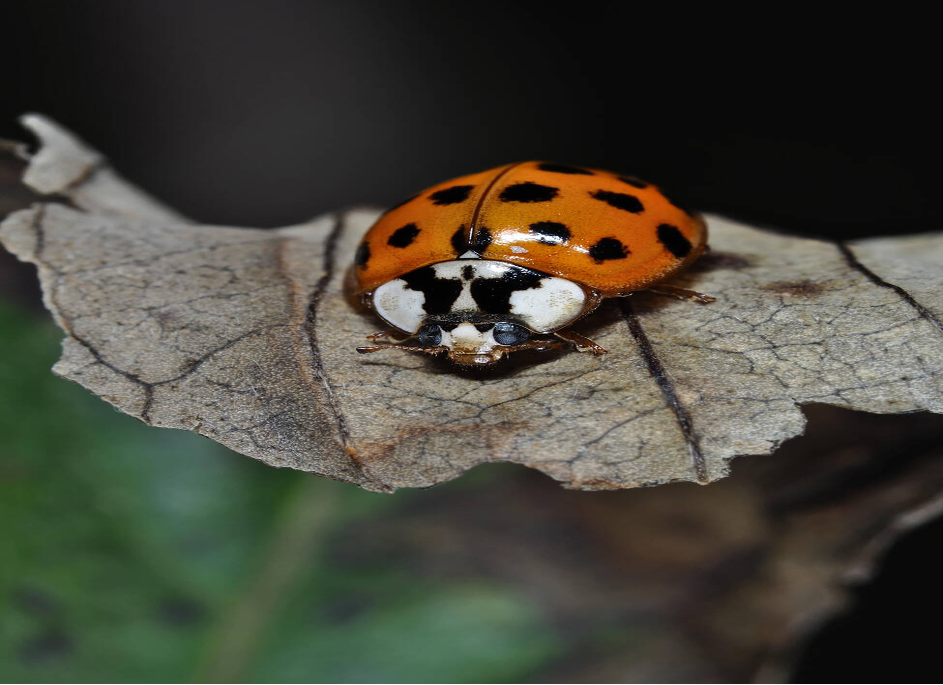
They often get mistaken for the native ladybug. Asian lady beetles can be distinguished by their larger white “cheek” markings and an ‘M’ marking near the head.
These beetles, introduced to control aphids, have become a dominant species in many regions, often pushing out native ladybugs.
- The Asian Lady Beetle (Harmonia axyridis)
3. Larch Ladybugs
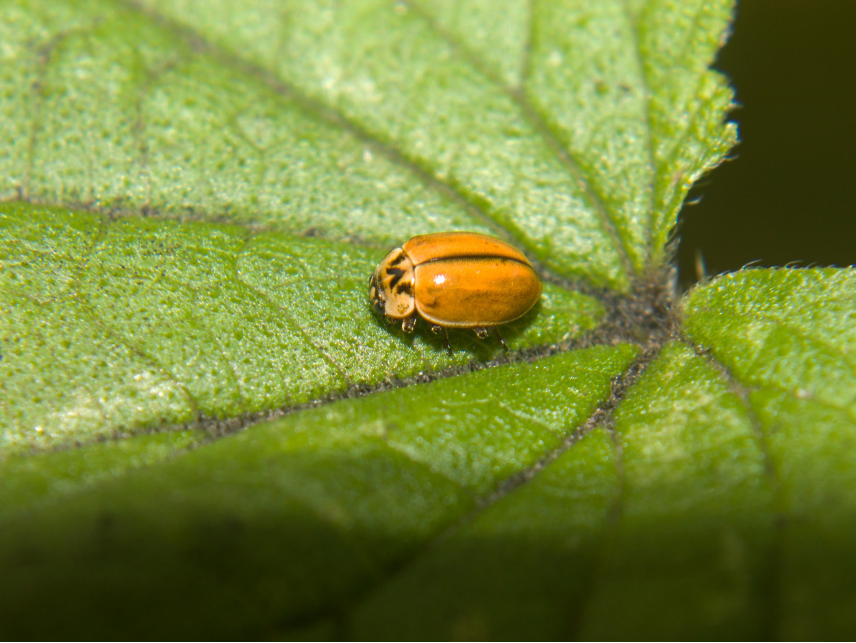
These are a specific type of brown ladybug that relies heavily on camouflage for protection. Their coloration allows them to blend in with the bark of trees, making them less visible to predators. Their back lacks any markings but has M shaped marking on their pronotum.
4. Variants with Unique Patterns
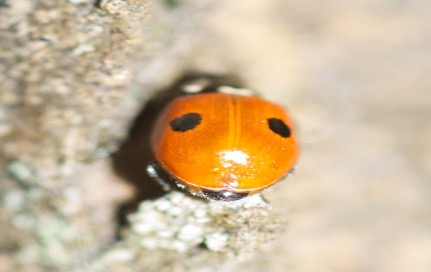
While most brown ladybugs are solid-colored, some exhibit unique patterns on their elytra (wing covers). These patterns can range from spots to stripes, adding to their distinctiveness.
Spots
- Two-Spotted Lady Beetle (Adalia bipunctata)
- The Thirteen-Spotted Lady Beetle (Hippodamia tredecimpunctata)
- Eye-Spotted Ladybug (Anatis mali)
- Cream-Spot Ladybug (Calvia quattuordecimguttata)
- Eighteen-Spot ladybug (Myrrha octodecimguttata)
- Fourteen-spotted Lady Beetle (Propylea quatuordecimpunctata)
- Arboreal Ladybird (Rhyzobius chrysomeloides)
- Mexican Bean Beetle (Epilachna varivestis)
- Vibidia duodecimguttata
Mottled Appearance
- Painted Ladybug (Mulsantina picta)
- Heather Ladybug (Chilocorus bipustulatus)
Stripped
- Three-Striped Ladybug (Brumoides suturalis)
- Eighteen-Spot ladybug (Myrrha octodecimguttata)
- Fourteen-spotted Lady Beetle (Propylea quatuordecimpunctata)
- Striped Ladybug (Myzia oblongoguttata)
- The Convergent Ladybug (Hippodamia convergens)
- Colorado Potato Beetle (Leptinotarsa decemlineata)
Are Brown Ladybugs Harmful?
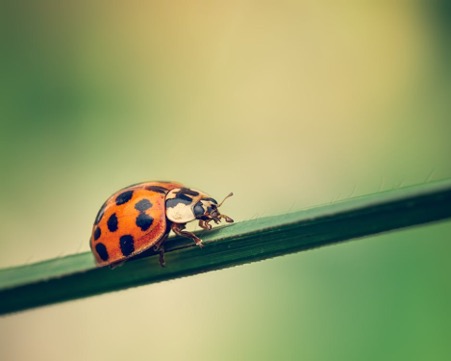
While ladybugs are not poisonous to humans, some species can be harmful to pets. Dogs that consume ladybugs may experience side effects such as drooling, vomiting, and behavioral changes.
Some ladybugs, especially the Asian Lady Beetles, can bite, leaving a mark. Moreover, they secrete a musky smell, which is actually their blood, when threatened.
Asian Lady Beetles vs. Native Ladybugs
One of the most common brown ladybugs is the Asian Lady Beetle (Harmonia axyridis). Introduced to North America in 1916 to combat aphids, these beetles have overtaken native ladybug species.
They can be distinguished from native ladybugs by their larger white “cheek” markings and an ‘M’ marking near the head. Unlike native ladybugs, Asian Lady Beetles can infiltrate homes during colder months and release an unpleasant odor when disturbed.
Common Brown Ladybug Species and How to Identify Them?
1. The Convergent Ladybug (Hippodamia convergens)
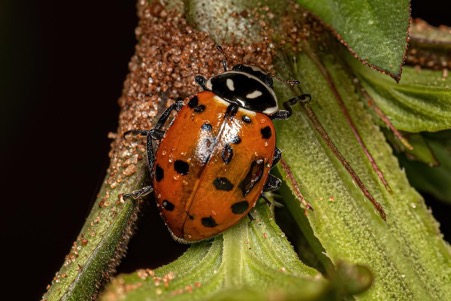
With its distinct brown or tan hue and a variable number of spots, this species is a familiar sight across North America. Their voracious appetite for aphids has earned them the reputation of being efficient natural pest controllers in gardens and agricultural fields.
What Should You Know?
Color: Orange-brown with various numbers of black spots on elytra. The head has two white lines that converge towards the tip
Spots: Typically 13 spots on each elytron, arranged in a clear pattern.
Size: About 5-7 mm in length.
Habitat: Common in North America, found in gardens, fields, and forests.
Behavior: Voracious aphid predators, can be seen clustered in groups during colder months.
Diet: Primarily consumes aphids.
Does it bite: No, but it might pinch when feel threatened
Are they harmful: The bite is not harmful to humans.
What should you do: Handle them gently, if needed, to avoid provoking them and causing distress.
How to Identify It?
Spot this brownish ladybug with its red or orange body and black spots converging at the center. It typically has 13 to 22 spots and measures about 5 to 7 millimeters in length.
2. The Asian Lady Beetle (Harmonia axyridis)
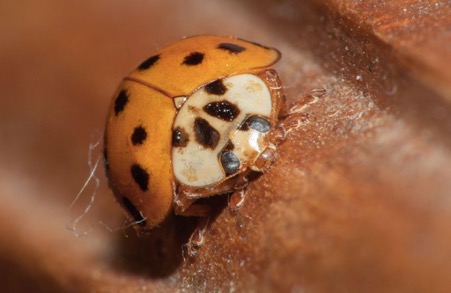
Though it also comes in various colors, including orange and red, the Asian Lady Beetle’s brown variant is particularly intriguing. Introduced to North America for aphid control, its populations have exploded, raising concerns due to its invasive tendencies.
What Should You Know?
Color: Ranges from light tan to deep orange-brown, often with variable spots.
Spots: The number of spots varies, can be none or many, and they might fade with age.
Size: Approximately 5-8 mm long.
Habitat: Originally from Asia, now widespread; found in gardens, fields, and homes.
Behavior: Effective aphid predator but can become invasive and aggregate indoors.
Diet: Aphids, mites, mealybugs, scale insects, and fall-ripening fruits
Does it bite: Yes, they can be aggressive and may bite when threatened.
Are they harmful: Yes, they can invade homes and release an unpleasant odor when disturbed. They also have the potential to harm dogs.
What should you do: Try to remain calm and avoid crushing or agitating it to prevent the release of its defensive odor. Call an exterminator.
How to Identify It?
This brown beetle can vary in color from tan to red or orange and has numerous black spots on its wings.
3. Two-Spotted Lady Beetle (Adalia bipunctata)
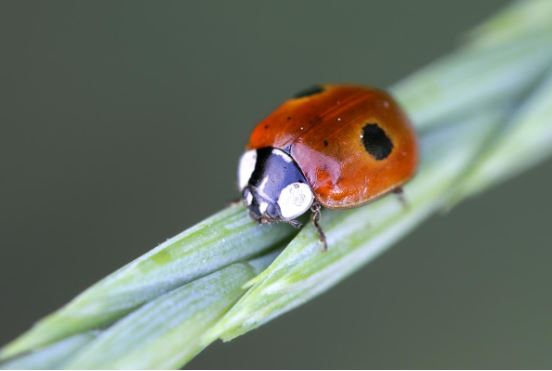
Sporting two prominent spots on its brown elytra, this species is a common sight in gardens across Europe. Their diet includes aphids, mealybugs, and other soft-bodied insects that can damage plants.
What Should You Know?
Color: Brownish-red with two distinctive round black spots on each elytron.
Spots: Two large black spots, one on each elytron.
Size: Around 4-6 mm in length.
Habitat: Native to Europe, also found in North America; often seen on vegetation.
Behavior: They are beneficial insects that feed on plant pests, exhibiting gentle behavior.
Diet: Feeds on aphids, scales, and other soft-bodied insects.
Does it bite: They do not bite humans.
Are they harmful: They are not harmful to humans and are considered helpful in gardens.
What should you do: Handle them gently if necessary and release them outside if indoors.
How to Identify It?
Identify them by their small size, red to orange brown color, black spots, and distinct two-spot pattern on their elytra (wing covers). They have a black head with yellow markings.
4. The Thirteen-Spotted Lady Beetle (Hippodamia tredecimpunctata)
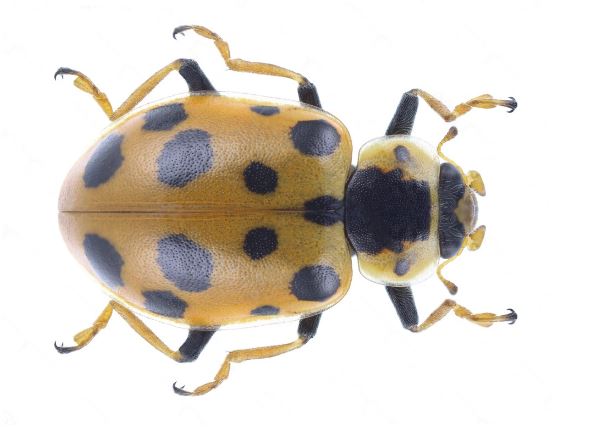
Named after the 13 spots adorning its elytra, this ladybug species is found in North America. With an insatiable appetite for aphids and other pests, this tiny but tenacious beetle plays a crucial role in maintaining plant health. Its vibrant appearance and voracious appetite make it a charming and beneficial guest in gardens around the world.
What Should You Know?
Color: Brown with 13 black spots on each elytron.
Spots: Exactly 13 spots on each elytron.
Size: About 5-7 mm in length.
Habitat: Native to North America; frequents gardens, fields, and shrubs.
Behavior: Is active and agile, often moving swiftly among plants to feed on pests.
Diet: Primary diet consists of aphids and other soft-bodied insects, making it a valuable natural pest controller.
Does it bite: Does not bite humans and is harmless to people.
Are they harmful: These lady beetles are not harmful; they’re beneficial for gardens due to their pest-eating habits.
What should you do: Allow them to thrive in your garden as they help control harmful insect populations.
How to Identify It?
Recognize them by their small size, bright red or orange color, and thirteen distinctive black spots on their elytra.
5. Larch Ladybug (Aphidecta obliterata)
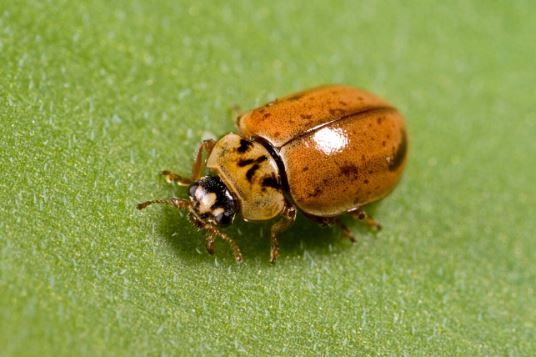
Meet the larch ladybug, one of the most common brown beetles found on North American plants. You’ll spot them on pine, spruce, and larch trees, where they munch on aphids during spring and summer, joining the league of aphid-hunting ladybirds.
What Should You Know?
Color: Generally orange-brown to red-brown.
Spots: Two distinct black spots on each elytron.
Size: Typically around 3-4 mm in length.
Habitat: Commonly found in coniferous forests and larch trees.
Behavior: Active aphid predator, often found near aphid colonies.
Diet: Feeds primarily on aphids and adelgids.
Does it bite: No..
Are they harmful: No, they are beneficial for controlling aphid populations.
What should you do: Nothing to worry about; appreciate them for their role in natural pest control.
How to Identify It?
It’s easily recognized by its tan to brown elytra, marked with an M shape on its pronotum, and a complete black head. With a sleek black stripe along its back, it resembles a light coffee bean. Unlike other ladybugs, its back lacks distinct black or white markings.
6. Painted Ladybug (Mulsantina picta)
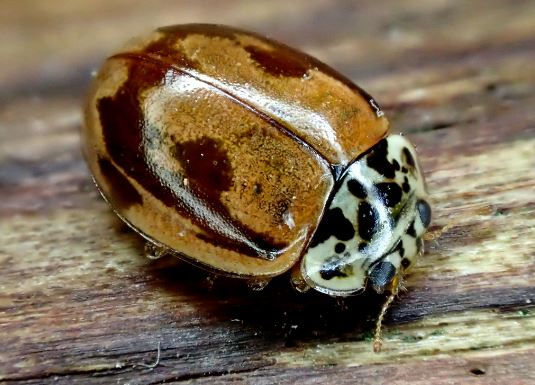
Also known as Pine Lady Beetles, these brown insects thrive in pine forests and have unique mottled patterns on their elytra. With brown legs, a black and white pronotum, and antennae, these small brown ladybugs feed on aphids and adelgids. The painted lady beetle comes in various colors like orange and black, red and black, or pale brown with dark markings.
What Should You Know?
Color: Typically bright orange to red with black markings.
Spots: Black spots on elytra, variable in number and arrangement.
Size: Usually around 2-4 mm in length.
Habitat: Found in gardens, meadows, and grassy areas.
Behavior: Active aphid predator, often seen on plants.
Diet: Feeds primarily on aphids and other soft-bodied insects.
Does it bite: No.
Are they harmful: No, they are beneficial predators for pest control.
What should you do: Encourage them as natural pest controllers in gardens.
How to Identify It?
Look for bright orange-red brown color, mottled black spots on their elytra, their presence on plants, and black and white pronotum. Compare it with references for accurate identification.
7. Eye-Spotted Ladybug (Anatis mali)
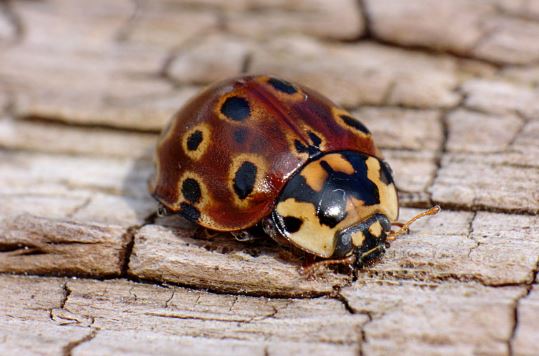
The eye-spotted ladybug stands out with reddish-brown shiny elytra decorated by eye-like marks—black dots circled in creamy white. The species with black pronotum had white markings at their base and sides.
Commonly found in tree canopies, especially in conifer forests, these ladybugs feed on aphids from late April to October.
With eight eye spots on each elytron, these reddish-brown ladybugs sport 16 in total, a unique trait that distinguishes them from the brown variation of the fifteen-spot ladybug, which has 15 black spots.
What Should You Know?
Color: Typically orange to red brown with black markings.
Spots: 16 Black spots and eye-like patterns on elytra.
Size: Generally around 7-10 mm in length.
Habitat: Found in orchards, gardens, and grassy areas across North America.
Behavior: Active aphid predator, often near aphid colonies.
Diet: Feeds primarily on aphids and other soft-bodied insects.
Does it bite: No..
Are they harmful: No, they are beneficial for controlling aphid populations.
What should you do: Sit back and let them do wonders with their natural pest control.
How to Identify It?
Look for orange-red color, black spots, and distinctive eye-like patterns on each elytra. The black spots are surrounded by a creamy white rim.
8. Three-Striped Ladybug (Brumoides suturalis)
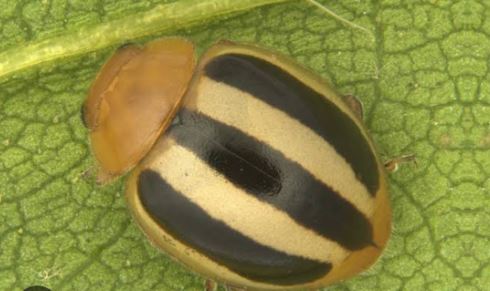
As the name suggests, this ladybug has three distinct stripes. Distinguished by its striking appearance, the three-striped ladybug features captivating golden-brown stripes over a black body, while its head, thorax, and legs sport a warm brown hue. Variations of this ladybug include black and white stripes accompanied by a pale brown head and thorax, showcasing a beautiful array of colors and patterns.
What Should You Know?
Color: Usually reddish-brown to black with three yellow stripes.
Spots: Generally lacks spots; has yellow stripes instead.
Size: Typically around 2-3 mm in length.
Habitat: Found in meadows, grasslands, and gardens of various regions of North America.
Behavior: Active predator, often seen on plants and flowers.
Diet: Feeds primarily on aphids and small insects.
Does it bite: No.
Are they harmful: No, they are beneficial insects for controlling pests.
What should you do: Promote their growth for natural pest management.
How to Identify It?
Look for reddish-brown to black color, three yellow stripes, and their presence on plants.
9. Cream-Spot Ladybug (Calvia quattuordecimguttata)
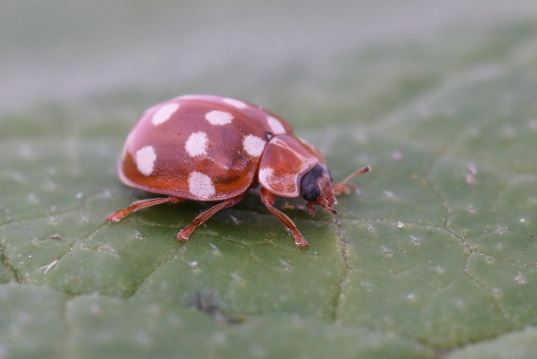
The cream-spot ladybug is a medium-sized brown insect with walnut-brown wings and 14 white spots on its wing cases. It’s also called the polka dot lady beetle and is common in North America. It lives in various places like forests, parks, and meadows, and eats aphids and psyllids. Its larvae look like small alligators with white markings and rows of spines on their backs.
What Should You Know?
Color: Typically reddish-brown with cream-colored spots.
Spots: Cream spots with a variable number on each elytron, usually 14..
Size: Generally around 4-5 mm in length.
Habitat: Various habitats including gardens, meadows, and vegetation-rich areas.
Behavior: Active aphid predator, often found on plants.
Diet: Feeds primarily on aphids and other soft-bodied insects.
Does it bite: No
Are they harmful: No, they are beneficial for controlling aphid populations.
What should you do: Don’t scare the bugs and let them do their work.
How to Identify It?
Find this little brown ladybug by its reddish-brown color, cream spots on its back, and one spot on either side of its black pronotum. You can easily spot them on plants.
10. Heather Ladybug (Chilocorus bipustulatus)
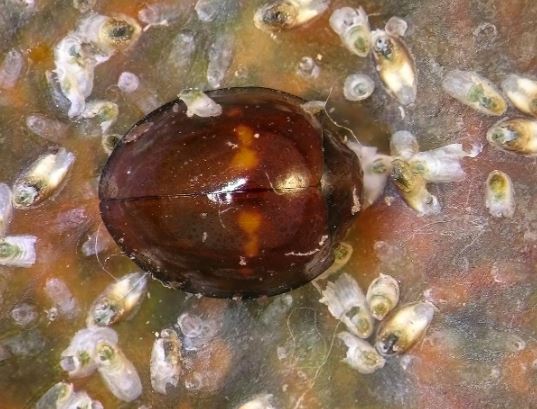
The heather ladybug, commonly found in heather environments, is characterized by its glossy dark brown elytra adorned with two reddish-orange spots. Some variants even exhibit three small red dots that form a horizontal line when observed from the top.
This beetle species stands out due to its domed wing covers that feature a prominent rim. While its main coloration is a rich brown, some appear almost black with four to six red spots. The beetle’s head, feet, antennae, and underside are consistently black.
What Should You Know?
Color: Glossy black or dark brown.
Spots: Typically has two red spots, one on each elytron.
Size: Usually around 3-5 mm in length.
Habitat: Common in heathlands, gardens, and woodland clearings.
Behavior: Active predator, often found on shrubs and low vegetation.
Diet: Feeds primarily on scale insects.
Does it bite: No, they do not bite humans.
Are they harmful: No, they are beneficial insects for controlling scale insects.
What should you do: Encourage their presence for natural scale insect control in gardens.
How to Identify It?
Look for the glossy dark coloration with two red spots on elytra and its preferred habitats. A distinctive feature of this shiny brown ladybug is its domed wing covers with a pronounced rim around the edges.
11. Mealybug Ladybug (Cryptolaemus montrouzieri)
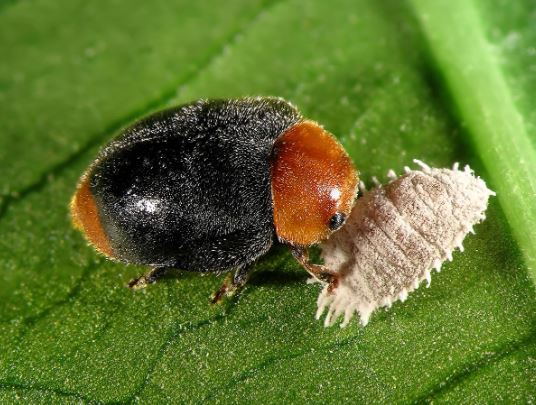
The mealybug ladybird, also known as the mealybug destroyer, has a dark brown or black body with an orange-brown head. Covered in fine hairs, it has a silvery appearance and orangey-brown legs and antennae. Unlike other ladybugs, it lacks spots on its elytra. Both its larvae and adults feed on mealybugs and scale insects, with the larvae mimicking fluffy white mealybugs.
What Should You Know?
Color: Typically dark brown to black.
Spots: Generally lacks spots, but has a distinctive appearance.
Size: Usually around 3-5 mm in length.
Habitat: Found in various regions including gardens, greenhouses, and areas with mealybug infestations.
Behavior: Active predator that targets mealybugs at various life stages.
Diet: Feeds primarily on mealybugs, especially the juvenile stages.
Does it bite: No.
Are they harmful: No, they are beneficial insects for mealybug control.
What should you do: Introduce or encourage them in infested areas for natural mealybug control.
How to Identify It?
Spot these bugs with their dark brown to black color, fine hairs, and silvery appearance and their association with mealybug-infested areas. Their wings lack any spots.
12. Mexican Bean Beetle (Epilachna varivestis)
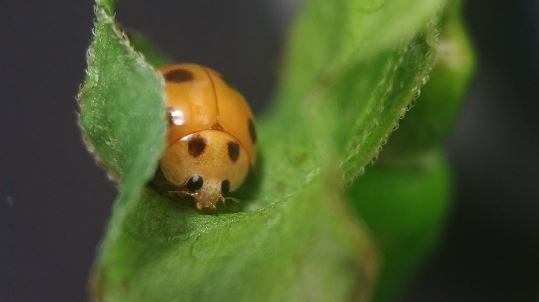
The Mexican bean beetle, a member of the Coccinellidae family, is classified as a true ladybug. This oval beetle, which can be rusty brown or golden yellow, is adorned with several black dots on its elytra.
While most ladybugs are beneficial and feed on other insects, Mexican bean beetles are exceptions. Both their larvae and adults feed on the flowers, leaves, and plant tissue of beans and other legumes, causing damage to crops in America.
What Should You Know?
Color: Generally coppery brown with black spots.
Spots: 16 black spots on each elytron, sometimes varying in pattern.
Size: Typically around 6-7 mm in length.
Habitat: Found in bean fields, gardens, and agricultural areas; predominant in North America.
Behavior: Feeds on bean plants, including leaves and pods.
Diet: Primarily feeds on bean plants, causing damage.
Does it bite: No, it does not bite humans.
Are they harmful: Yes, they are harmful garden pests damaging bean crops.
What should you do: Consider using strategies like introducing natural predators, including ladybugs and lacewings, or planting specific trap crops. While it requires effort, hand-picking remains one of the most reliable methods for eliminating these beetles.
How to Identify It?
Look for its distinctive coppery brown color, 16 small black spots on each elytron, and its presence on bean plants.
13. Kudzu Bug (Megacopta cribraria)
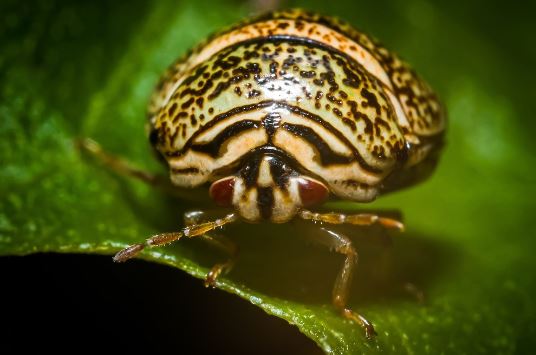
The Kudzu Bug, commonly referred to as the square bug, is a small, olive-green brownish insect native to Asia. Notoriously known for its invasive nature, this pest has rapidly expanded its presence in the U.S., particularly targeting kudzu plants.
However, its appetite isn’t limited to kudzu; it can also feed on soybeans and other legumes, often posing challenges for farmers. With a distinctive square-shaped body, this flying insect stands out and has become a subject of increased study due to its impact on agriculture.
What Should You Know?
Color: Typically olive-green to brown.
Spots: Often has speckled markings on the abdomen.
Size: Usually around 3-5 mm in length.
Habitat: Native to Asia, found in areas with kudzu and other plants.
Behavior: Feeds on various plants, including kudzu vine and soybeans; may invade home.
Diet: Primarily feeds on plant sap of soybeans.
Does it bite: No, it does not bite humans.
Are they harmful: Yes, they can be harmful to crops like soybeans.
What should you do: Implement control measures to manage their population and protect crops.
How to Identify It?
Look for the olive-green to brown color, speckled abdomen, and its presence on kudzu or other plants.
14. Ashy Gray Lady Beetle (Olla v-nigrum)
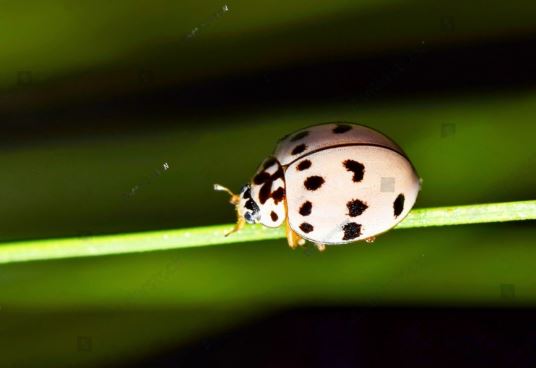
The Ashy Gray Lady Beetle, *Olla v-nigrum*, is a muted gray beetle highlighted by a distinctive black “V” or “U” mark. Beyond its unique appearance, it’s a gardener’s friend, preying on pests. Amidst the bright world of beetles, it stands out with its subtle beauty.
What Should You Know?
Color: Muted gray-brown.
Spots: Characteristic black “V” or “U” mark.
Size: Approximately 4-5 mm in length.
Habitat: Gardens, meadows, and agricultural fields.
Behavior: Predatory and beneficial to gardeners.
Diet: Aphids and other small soft-bodied insects.
Does it bite: Rarely, if ever.
Are they harmful: No, they are beneficial predators of pests.
What should you do: Allow them to thrive in gardens.
How to Identify It?
Look for its gray coloration with a distinctive black “V” or “U” marking.
15. Arboreal Ladybird (Rhyzobius chrysomeloides)
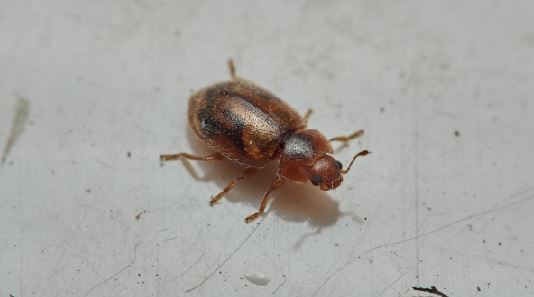
The Rhyzobius chrysomeloides is a brown ladybug with fine hairs on its dark wing covers. It has six legs, an oval shape, and straight antennae.
The head and pronotum feature black and brown markings, mirroring the patterns on its hairy wing covers. These brownish ladybugs often have black and brown patterns and are commonly found on trees, especially near ivy.
What Should You Know?
Color: Generally black with an orange-red border on the pronotum.
Spots: Often lacks spots, and has distinctive orange-red markings.
Size: Typically around 2-3 mm in length.
Habitat: Used for biological control in greenhouses and gardens.
Behavior: Released to control aphids on plants as biological control agent.
Diet: Feeds primarily on aphids.
Does it bite: No, it does not bite humans.
Are they harmful: No, they are beneficial insects used for pest control.
What should you do: Introduce or encourage them for natural aphid control.
How to Identify It?
Look for black color with an orange-red pronotum border and their presence in managed environments.
16. Vibidia Duodecimguttata
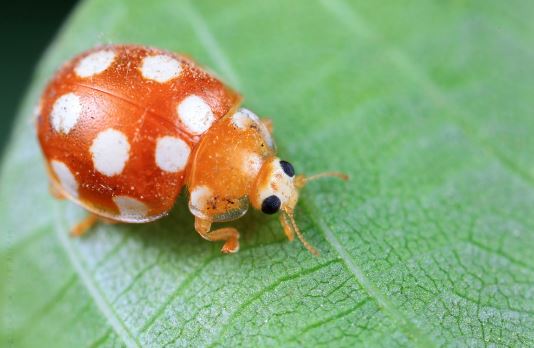
The Vibidia duodecimguttata is a pale brown flying beetle, distinguishable by vibrant white spots on its domed elytra. This ladybug showcases an oval body with six pairs of white spots, light brown legs, black eyes, and two additional white spots on its head’s side. Contrary to most predatory ladybugs, it preys on powdery mildew fungus instead of insects. Active from April to September, its scientific name hints at the 12 characteristic spots on its back.
What Should You Know?
Color: Generally reddish-brown with twelve cream-colored spots.
Spots: Twelve distinct cream-colored spots on its elytra.
Size: Typically around 4-5 mm in length.
Habitat: Found in gardens, grasslands, and meadows.
Behavior: Active aphid predator often spotted on vegetation.
Diet: Feeds primarily on aphids and other soft-bodied insects.
Does it bite: No.
Are they harmful: No, they are beneficial insects for controlling aphid populations.
What should you do: Welcome them in your gardens for natural aphid control.
How to Identify It?
Look for the reddish-brown color, twelve cream-colored spots, and their presence on plants. Compare references for accurate identification.
17. Eighteen-Spot ladybug (Myrrha octodecimguttata)
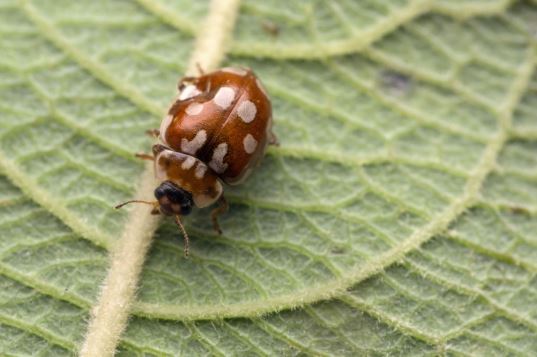
The eighteen-spot ladybug is distinguishable by its striking orange-brown or maroon-brown hue, adorned with creamy white patches on its back. The most notable identifying characteristic is its nine pairs of white spots.
Active from late spring to fall, these ladybugs thrive in the canopies of both coniferous and deciduous forests. Their larvae are carrot-shaped, pale gray with black tubercles, and showcase yellow or bright orange markings on their abdominal segments.
What Should You Know?
Color: Typically red to orange brown with cream-colored spots.
Spots: Eighteen cream-colored spots on its elytra.
Size: Generally around 4-5 mm in length.
Habitat: Found in woodlands, gardens, and meadows.
Behavior: Active aphid predator often seen on various vegetation.
Diet: Feeds primarily on aphids and other soft bodied pests.
Does it bite: No.
Are they harmful: No, they are beneficial insects for controlling aphid populations.
What should you do: Don’t pick on them to assist in natural pest control.
How to Identify It?
Look for the red-orange color elongated shape body, eighteen irregular cream-colored spots, brown legs, compound eyes, and their presence on plants.
18. Fourteen-spotted Lady Beetle (Propylea quatuordecimpunctata)
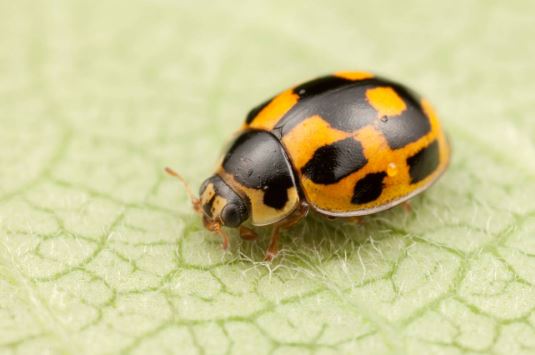
The Fourteen-spotted Lady Beetle, Propylea quatuordecimpunctata, boasts a pale brown hue with 14 distinct black spots. Active in gardens, it’s both a visual treat and a defender against aphids. Its striking design highlights nature’s blend of beauty and function in the beetle world.
What Should You Know?
Color: Pale brown.
Spots: 14 square-shaped black spots.
Size: Approximately 3-4 mm in length.
Habitat: Gardens, meadows, and agricultural areas.
Behavior: Predatory and active during the daytime.
Diet: Aphids and other small soft-bodied insects.
Does it bite: Rarely, if ever.
Are they harmful: No, they are beneficial predators of pests.
What should you do: Let them be, as they aid in natural pest control.
How to Identify It?
Look for its pale yellow brown coloration with 14 black square spots on its wing covers.
19. Striped Ladybug (Myzia oblongoguttata)
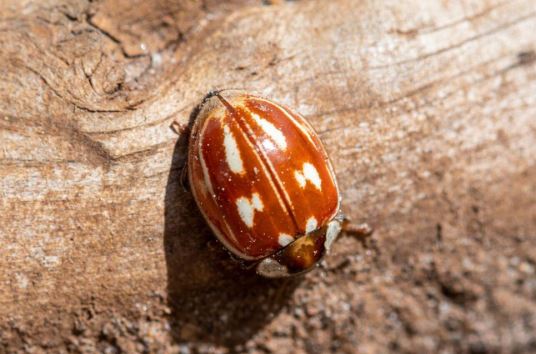
Commonly found on pine, spruce, and beech trees, the striped ladybug is a brown species characterized by its chestnut color with creamy-white spots and stripes on the elytra. It has a black head and large white patches on its brown thorax.
Beneficial in nature, these ladybirds assist in controlling aphid populations. Active from spring to late summer, they seek shelter during winter in tree crevices and organic debris scattered on the forest floor.
What Should You Know?
Color: Generally reddish-brown with cream-colored spots.
Spots: Cream-colored spots, often elongated or irregular in shape.
Size: Typically around 6-8 mm in length.
Habitat: Found in woodlands, gardens, and meadows.
Behavior: Active aphid predator often observed on plants.
Diet: Feeds primarily on aphids and other small insects.
Does it bite: No, it does not bite humans.
Are they harmful: No, they are beneficial insects for controlling aphid populations.
What should you do: Encourage their presence in gardens for natural pest control.
How to Identify It?
Look for reddish-brown color, cream-colored spots and strips at the back, and their presence on plants.
Brown Bugs that Look Like Ladybugs:
20. Colorado Potato Beetle (Leptinotarsa decemlineata)
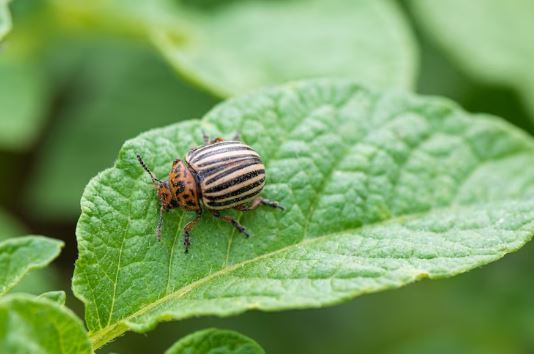
Also known as the ten-lined potato beetle, the Colorado potato beetle boasts a distinctive oval body with pale brown-beige stripes. These striped, orange-pale brown bugs can wreak havoc on potato crops. Not only can they defoliate potato plants, but they also damage tomato leaves and eggplant crops. In extreme instances, a significant infestation can lead to the loss of an entire crop.
What Should You Know?
Color: Typically bright red or orange with black stripes.
Spots: Ten distinctive black stripes on its elytra.
Size: Generally around 6-11 mm in length.
Habitat: Found in agricultural areas where potatoes are cultivated.
Behavior: Feeds voraciously on potato foliage, causing damage.
Diet: Primarily feeds on potato plants.
Does it bite: No, it does not bite humans.
Are they harmful: Yes, they are harmful pests that can damage potato crops.
What should you do: Implement pest management strategies to protect potato plants from infestations.
How to Identify It?
Look for bright red or orange brown color, ten black stripes, and its presence on potato plants.
21. Brown Carpet Beetle (Attagenus smirnovi)
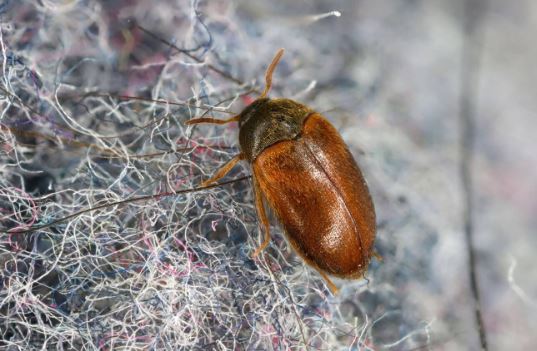
Brown carpet beetles, prevalent in many North American homes, resemble ladybugs with their oval-shaped bodies and shades of brown elytra to black pronotum. Despite their similarities, these beetles are known to feed on carpets, fabrics, and furs, causing damage like holes in carpets, upholstery, and clothing.
What Should You Know?
Color: Typically mottled brown or dark coloration.
Spots: Often lacks spots, with intricate patterns on its elytra.
Size: Usually around 2-4 mm in length.
Habitat: Found indoors, commonly infesting stored products.
Behavior: Larvae feed on various organic materials, including textiles and animal products.
Diet: Larvae consume a wide range of organic matter.
Does it bite: No, it does not bite humans.
Are they harmful: Yes, they can damage stored items and fabrics.
What should you do: Implement preventive measures to protect stored items from infestations like maintaining cleanliness and regular vacuuming.
How to Identify It?
Look for the mottled brown or dark coloration and its presence in stored materials.
22. June Bugs (Melolonthinae Phyllophaga)
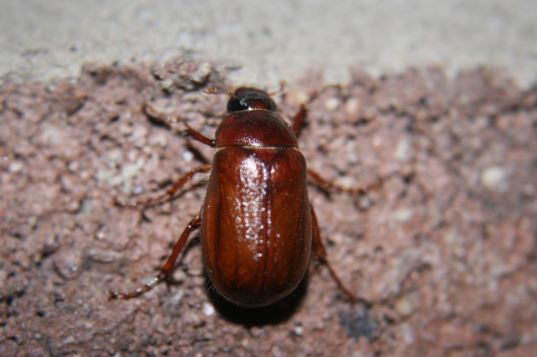
June bugs, also known as May beetles, are nocturnal beetles. These beetles are a common sight in North America and are often remembered for their habit of buzzing around porch lights and windows. While the adults are relatively harmless, the larvae, known as white grubs, can be problematic for gardeners and lawn enthusiasts due to their feeding habits.
What Should You Know?
Color: Typically brown or greenish-brown.
Spots: Generally, they lack spots.
Size: Approximately 0.5 to 1 inch in length.
Habitat: Forests, gardens, and fields.
Behavior: Attracted to lights and active during the early summer nights.
Diet: Adult June bugs feed on tree leaves, while larvae (grubs) feed on plant roots.
Does it bite: No, but they might cling if they land on you.
Are they harmful: Larvae can damage lawns and gardens by feeding on roots.
What should you do: Reduce outdoor lighting during peak activity and maintain a healthy lawn to deter larvae.
How to Identify It?
Look for a stout-bodied, brown or greenish-brown beetle, active during early summer nights.
Tips to Attract and Promote Beneficial Brown Ladybugs in Gardens and Farms
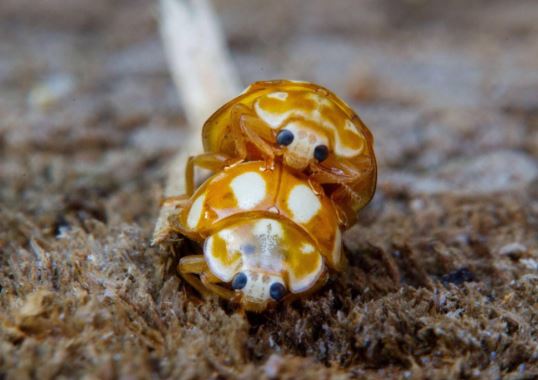
For gardeners and farmers, the diversity of brown ladybugs offers a range of benefits. These unassuming insects act as natural allies, reducing the need for chemical pesticides.
By attracting and fostering brown ladybug populations, agricultural practitioners can create more sustainable and environmentally friendly farming practices. Here are a few tips to promote beneficial brown bugs in your garden.
Avoid Pesticides
Reduce or eliminate the use of chemical pesticides, which can harm ladybugs. If needed, choose organic or less toxic varieties.
Plant Attractive Plants
Growing a varied mix of plants ensures a continuous food source for ladybugs and maintains a balanced ecosystem. Incorporate plants like angelica, dill, calendula, cosmos, and fennel that provide nectar, pollen, or host pests for ladybugs.
Provide Habitat
Create shelters for ladybugs using patches of wild growth, ladybug houses, or by offering a water source through shallow dishes filled with pebbles.
Reduce Tilling
Limit soil tilling to avoid destroying ladybug pupae and maintain their natural habitat.
Maintain Aphid Populations
While this may sound counterintuitive, if there’s no food, ladybugs won’t stick around. Maintaining a small aphid population can serve as a food source for ladybugs and entice them to stay.
Preventing and Controlling Brown Ladybug Infestation
Pest control is important. If you find brown ladybugs (often called the Asian lady beetle) becoming a nuisance, especially in and around homes, here are five tips to prevent and control their infestation:
Seal Entry Points
Before the onset of winter, inspect your home for cracks, crevices, and other potential entry points. Seal gaps around windows, doors, utility pipes, and chimneys. Use caulk or weather stripping to close off these areas. Installing screens over roof vents.
Reduce Lighting
Brown ladybugs are attracted to light. Minimize the use of outdoor lighting during the evening, or switch to yellow bulbs which are less attractive to these insects.
Use Natural Repellents
Diatomaceous earth can be sprinkled in areas where ladybugs congregate. It causes dehydration and death in insects but is non-toxic to humans and pets.
Another natural repellent is a citrus or clove scent, which can deter ladybugs when sprayed in infested areas. For natural deterrents, planting mums and lavender can keep ladybugs at bay.
Indoor Vacuuming
If ladybugs are already inside your home, the most effective and humane way to remove them is by using a vacuum. After vacuuming them up, you can release them outside.
Make sure to empty the vacuum or change its bag after using it for this purpose to prevent them from coming back out or leaving an unpleasant odor.
Consult with Pest Control Professionals
If the infestation is severe, it might be wise to contact residential pest control professionals who can offer more robust solutions while ensuring the safety of your living environment.
Conclusion
Brown ladybugs, though less common than their red counterparts, play a crucial role in maintaining ecological balance by feeding on pests. While ladybugs, in general, are beneficial for the environment, it’s essential to be aware of the different species and their behaviors.
Brown ladybugs, especially the Asian Lady Beetles, can become a nuisance if not managed properly. By understanding their characteristics and taking preventive measures, one can ensure a harmonious coexistence with these tiny creatures.

